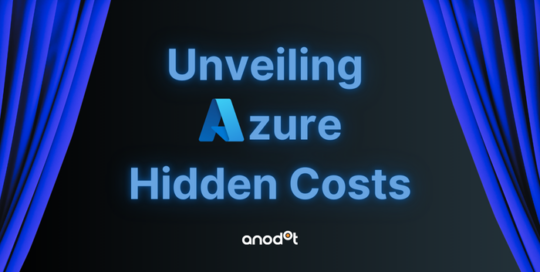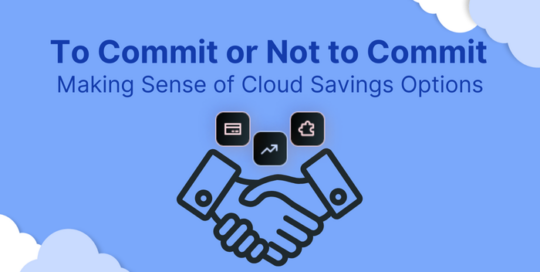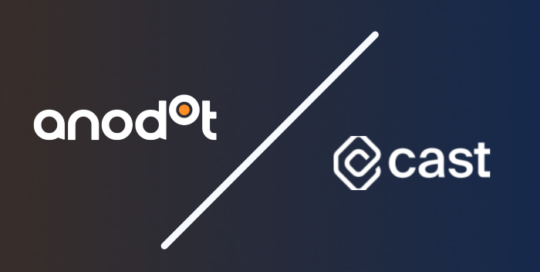Trying to find the best virtual machine on the market that gives you the flexibility of easy scalability and the promise of a secure network – and doesn’t cost an arm and a leg (and maybe another arm)?
Azure VM is likely the best solution for you… assuming you can project costs correctly. However, Azure doesn’t make it easy with its different offerings and pricing models. It’s worth noting that Azure VM pricing is competitive compared to other cloud service providers, especially when you consider the flexibility and scalability it offers.
We’ll break things down so you can determine which pricing model and Azure VM type is best for your company – and your budget.
In this article:
- What is Azure VM?
- What are the Azure VM pricing models?
- What Azure VM type should I get?
- Optimize your Azure VM spend with Anodot solutions
What is Azure VM?
Azure VM or Azure Virtual Machines is Azure’s on-demand cloud-based computing resource for Linux or Windows users to run, develop, or test applications and systems. It helps improve storage and network output with custom hardware and provides advanced security to protect against cybersecurity attacks across any platform or device.
Azure VMs are scalable, so you can comfortably increase your usage to the thousands depending on your needs. You can scale across the cloud, adding or eliminating VMs according to live demand, giving you flexible scalability. This means you can adjust your VM resources in real-time to match your workload, which can help you optimize performance and control costs. Azure VM also enables you to connect VMs to your network, creating an extended data center.
But, as we said above, Azure VMs are tricky regarding price.
Different types of VMs are available for purchase, with pay-as-you-go, one year, and three year payment cycles. We’ll start by breaking down the different Azure VM pricing models so you can decide which offering works best for you and your company.
What are the Azure VM pricing models?
There are three types of Azure VM pricing models. The best for your company depends on how many VMs you need and how long you need them.
Reserved VM instances pricing model
If you’re sure you need VMs for over a year or three in a specific region and have a steady use case for your application (and want to save up to 72% on VM prices), reserved VM instances are the way to go.
With this model, you can easily project VM prices for the next one to three years, get automated control of Azure RIs because of instance size flexibility, and be first in line for compute capacity in your Azure region.
If the one—or three-year commitment makes you nervous, you can always cancel early for a cancellation fee or exchange your selected VM service for another VM offering. You can also pay your bills monthly, not all upfront.
Pay-as-you-go pricing model
Pay-as-you-go pricing means Microsoft charges you for each second a VM is running. This means you’re only paying for active use, and careful attention to your resources is a must. This pricing model can be beneficial for companies with fluctuating workloads, as they only pay for the resources they use. However, careful monitoring and management of VM usage is required to avoid unexpected costs.
If you need the flexibility to increase or decrease your VM capacity and don’t want to lock in a one—or three-year commitment, this is a solid choice… so long as you’re prepared to eat the larger bill.
Free VM pricing model
Free! What’s not to like? Azure offers a free credit trial that allows you to earn $200 in credits for the first 30 days of your trial period. Other services are free for up to the first 12 months of using Azure products. This is a great opportunity for companies to test Azure VMs and other services without committing to a long-term contract or incurring immediate costs.
In that time, you can operate in any Azure-supported region and develop multiple instances (so long as you play within the confines of their free offerings). For example, you can use 750 hours for B1s burstable VM each month for up to 12 months.
The downside of this is apparent: if you’re handling heavier workloads, you will hit a wall and fast. But this is a great way to sample Azure’s services to see if they fit well with your company.
What Azure VM type should I get?
Azure Virtual Machines breaks down into six different categories:
| Type | Sizes | Description |
| General Purpose | Av2, B, DCv2, Dv2, DSv2, Dv3, Dsv3, Dav4, Dasv4,Ddv4, Ddsv4, Dv4,Dsv4 |
VM, with a balance of CPU to memory, is made for testing and development in small to medium databases.
|
| Compute Optimized | Fsv2, Fs, F |
Higher ratio of CPU to memory VM ideal for network applications, batch processing, and servers with medium traffic.
|
| Memory Optimized | Esv3, Ev3, M, GS, G, DSv2, DS, Dv2, D |
Ideal for medium to large in-memory analytics or relational database servers due to the higher ratio of memory to CPU.
|
| Storage Optimized | Ls |
Contains IO and high disk throughput, making it ideal for SQL/NoSQL databases, big data, data warehousing, and more.
|
| High-Performance Compute | H, A8-11 |
Premium CPU support and resources make this VM ideal for high computing and mission-critical tasks.
|
| GPU | NV, NC, NCv2, ND |
Provides GPU-based processing, making it ideal for model training and inference, rendering, and video editing.
|
Within each of these six categories, there are also 10 different sizes of Azure VM:
A series VM: Best for economical entry-level dev testing and code repositories. Basic and Standard A-series VMs will retire on August 31st, 2024. A-series prices start at $11.68 per month. For instance, a startup company that is developing a new software application might find the A series VMs to be a cost-effective option for their initial testing and development needs.
B series VM: Low-cost option for low to moderate baseline CPU utilization workloads that can burst to higher CPU if needed. Bursting is a feature that allows a VM to temporarily increase its performance to handle a sudden increase in workload. This can be beneficial for companies with unpredictable workloads, as it allows them to handle peak demands without having to provision additional resources. Bs-Series prices start at $3.80 per month.
D series VM: General purpose compute offering that can meet the vCPU, memory, and temporary storage requirements of most production workloads. Broken down into the Dv3, Dv4, Ddv4, Dv5, and other series, all of which have varying processing power. Prices start at $41.61 per month.
E series VM: Optimized for in-memory applications like SAP HANA, memory-intensive enterprise tools, and large database servers because of high memory-to-care ratio configurations. Prices start at $58.40 per month.
F series VM: Compute-optimized VM because of a higher CPU-to-memory ratio. Suitable for batch processing, analytics, gaming, and web servers. Prices start at $35.77.
G series VM: Two times more memory and four times more SSD storage than general-purpose D-series, making it suitable for large SQL and NoSQL databases, SAP, ERP, and data warehousing. Prices start at $320.47 per month.
H series VM: Broken down into the HB series, which is optimized for HPC applications like weather simulation and silicon RTL modeling. The HC-series is optimized for intensive computation HPC applications like implicit finite element analysis, computational chemistry, and reservoir simulation. Prices start at $581.08 per month.
Ls series VM: Storage-optimized VM ideal for low latency, local disk storage, and high-throughput applications. Prices start at $455.52 per month.
M series VM: Ideal for heavy in-memory workloads like SAP HANA with up to t4 TB of RAM on a single VM. Prices start at $1,121.28 per month. Also, the MV2-series offers 416 vCPU on a single VM and 3 TB, 6 TB, and 12 TB memory configurations. Prices start at $16,286.30 per month.
N series VM: GPU-enabled VM ideal for compute and graphic-intensive workloads. Broken down into the NC-series for high-performance computing and machine learning, the NDs-series ideal for training and deep learning, and the NV-series ideal for remote visualization workloads. Prices start at $657 per month.
Example setups
Azure VM pricing is complex because there are so many varieties to choose from. You’ll need to understand what kinds of servers you need support for, how much traffic you’re handling, and, more importantly, the tasks you’ll be undertaking. That will inform you which VM works best for you and how much that VM will cost.
For example, let’s say you’ve just started with some entry-level dev testing. The primary A series works best for you. If you need two cores, you’ll work with the A2 v2 instance, providing 4 GiB of RAM and 20 GiB of temporary storage. Here’s what your price breakdown would look like:
Pay as you go: $65.9190 per month
1-year savings plan: $44.5665 per month
3-year savings plan: $29.7110 per month
Say you need something with more computing that can handle most production workloads. You can go with the D series instead. If you’re looking for something with temporary local storage and processor frequencies that can reach up to 3.5GHz, the Dads v5 series is a good choice. If you need more RAM and temporary storage, go with the D48ads v5 instance, which provides 48 vCPUs, 192 GiB of RAM, and 1,800 GiB of temporary storage. Your Azure price breakdown would look like this:
Pay as you go: $1,804.5600 per month
1-year savings plan: $1,237.2869 per month
3-year savings plan: $825.9439 per month
Or maybe you don’t need any temporary storage but want VM-level isolation to help remove cloud operators without additional code modification. The DCasv5 series might be a good choice. You can go with the DC8as V5 instance, which provides 8 vCPUs and 32 GiB of RAM. Here’s your price breakdown:
Pay as you go: $251.1200 per month
1-year savings plan: $212.2986 per month
3-year savings plan: $163.4324 per month
All prices are for the East US region.
Need more info on Azure pricing plans? Check out our detailed guides to Azure Functions Pricing, Azure Hybrid Benefit and Azure Backup Pricing.

David Drai
CEO & Co-Founder, Anodot
David is dedicated to helping companies uncover business insights with AI analytics, backed by a strong background in leading tech innovations.
TIPS FROM THE EXPERT
1. Right-size your VMs based on workload
Regularly assess and right-size your VMs based on CPU, memory, and storage usage. Azure Advisor provides recommendations to help you avoid over-provisioning, which is crucial to keeping costs down without compromising performance.
2. Utilize burstable VMs for fluctuating workloads
For workloads with unpredictable usage, consider B-series VMs. These allow you to accumulate credits during low CPU usage, then “burst” when more processing power is needed. This approach balances cost and performance, especially for test or dev environments.
3. Use VM Scale Sets for auto-scaling
VM Scale Sets enable automatic scaling of VMs based on real-time demand. This helps optimize costs by adjusting resources dynamically to meet workload requirements, reducing the need for manual scaling or over-provisioning.
4. Take advantage of Free Tier and dev/test pricing
Use the Azure Free Tier for initial development and testing, especially for startups or small-scale projects. Additionally, take advantage of Dev/Test pricing to access discounted rates on VMs, which is a cost-effective option for non-production environments.
5. Optimize storage costs with managed disks
Choose managed disk types (Premium, Standard SSD, or Standard HDD) based on your performance needs. For high IOPS requirements, Premium SSDs are optimal, while Standard HDDs can be used for less critical storage to reduce costs.
Optimize your Azure VM spend with Anodot solutions
Now that you know the ins and outs of Azure pricing, don’t sweat about the final bill. Focus on providing quality services and meeting quarterly goals while saving up to 40% on annual cloud spend with Anodot’s Cloud Cost Management solution.
Anodot’s cloud cost management solution offers comprehensive visibility into your Azure VM bill, ensuring complete control over your cloud budget. An Anodot partnership means no surprise costs and unites your FinOps, DevOps, and Finance teams to drive down your overall expenditure.
Need proof of concept? Talk to us for more insight into cloud usage, costs, and how much you can save with Anodot’s tools.





